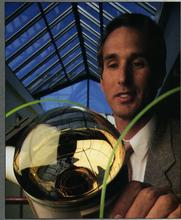
Professor (David M. Myers Distinguished Professor)
Research Interests:
Unification of the Particles & Forces of Nature using Novel Calorimetric Detectors
My main focus is exploring the unification of particle physics using novel calorimetric detectors. With colleagues, I designed and built the first massive liquid scintillator calorimeter and large area drift chambers, and performed the analysis that discovered neutral weak currents using neutrino beams in 1974. This work was the first to demonstrate that two of the four forces, the weak and the electromagnetic, are unified.
I then designed and prototyped a Cherenkov detector to search for the predicted signal of Grand Unification (proton decay) and for neutrino oscillations, which we discovered.
Applying the Cherenkov detection techniques to quartz fibers, my collaborators and I developed the forward calorimeter for the CMS detector at the Large Hadron Collider. This was instrumental in the discovery of the Higgs boson.
I love and nurture my students. So that they could be formed in the most challenging of world laboratories, I established in 2009 the BU/CERN/University of Geneva Program, the only one in the world to send junior physics majors (15) each year for a 6 to 8-month CERN internship.
Selected Publications:
For a full list of publications, please select the “View CV” tab at the right of the photo above.
For downloads of the selected talks below, please see my research website :
“Early history of the discovery of neutrino oscillations”, colloquium at the celebration of the 2015 Nobel Award, Uppsala, Sweden.
“La naissance de l’astronomie du neutrino et son avenir,” Keynote, 25th Anniversary, CPPM Lab, University of Marseille.
“The Birth of Neutrino Astrophysics,” Colloquium, McGill University.
“From the Big Bang to the End of Time,” All University Lecture, Carnegie Mellon University.
“Grand Unification: the Demise of the Proton,” Collins Lecture, Massachusetts General Hospital Endowed Series.
“From Alchemy to Quarks,” Lectures in the Boston University Core Curriculum by LRS.
“The BU Internship Program at CERN for Junior Physics Majors,” the only physics study abroad program at CERN.
Biography:
Lawrence R. Sulak studied CP violation under Wolfenstein (Carnegie Mellon, BS ‘66), Fitch (Princeton, PhD ‘70), and Turlay (at Saclay and CERN ‘71).
At Harvard, building the first two large (~100 T) totally absorptive calorimeters for FNAL and then BNL, he, Rubbia and collaborators at Penn and Wisconsin discovered weak neutral currents contemporaneously with CERN. Sulak’s team was the first to observe ν-nucleon elastic scattering (1975), further evidence for a unified electroweak force.
To search for proton decay, supernova ν’s, and ν oscillations, Sulak and his students at Harvard proposed (‘78) the first massive (10,000 T) water Cherenkov ring-imaging calorimeter. He, colleagues from Michigan, and collaborators from Irvine built that detector (IMB), proving (‘83) that the nucleon lives > 1032 years. However, they observed an anomalously low number of atmospheric νµ’s, that could not be confirmed by the competing Japanese experiment until 1986 after adopting several of the IMB technical strategies.
IMB was the first to observe neutrinos from a gravitational collapse (‘87) concurrently with the Japanese Kamiokande detector, confirming the models of supernova implosion and setting many limits on the properties of neutrinos.
Later, IMB collaborators and the Japanese united to build a combined second-generation detector, Super-K. They verified that both atmospheric and accelerator ν’s oscillate, proving that neutrinos have mass, a first indication of physics beyond the Standard Model.
To search for point sources of TeV neutrinos, Sulak and collaborators in France built the Antares Observatory, 2.4 km deep in the Mediterranean off the coast of France.
Applying Cherenkov technology to quartz fibers, Sulak spearheaded the development of the CMS Forward Hadronic Calorimeter, contributing to the discovery of the Higgs boson.
Modeled after his ‘78 proposal for IMB, 10 massive ring-imaging calorimeters in 7 countries on 4 continents have now studied neutrinos from accelerators, cosmic rays, reactors, and our sun.
Sulak’s honors include the 2018 Panosfsky Prize, the 2017 APS Instrumentation Award, the Rossi Prize of the American Astronomical Society, the Marseille Research Prize, the Asahi Prize, Fellowship in the American Physical Society, and a Guggenheim Fellowship.
Honors/Awards:
- Panofsky Prize, American Physical Society, the top APS award for an experimental physicist (2017)
- Instrumentation Award, American Physical Society, Division of Particles and Fields (2017)
- Physics Breakthrough Prize in Fundamental Physics, shared with SNO and collaborators in Super-K (2015)
- Most Distinguished Alumnus Award, Carnegie Mellon University (2006)
- ASAHI Prize, “Discovery of the Finite Mass of Neutrinos,” shared with Super-K collaborators (1998)
- Bruno Rossi Prize, American Astronomical Society for “Discovery of Neutrinos from Supernova 1987a” shared with IMB collaboration (1989)
- Fellow, American Physical Society (1984)